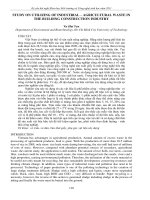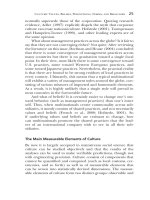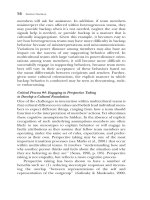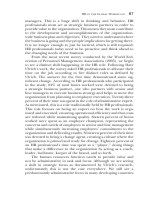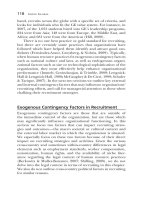Radioactive waste in the Barents and Kara Seas - Russian implementation of the global dumping regime
Bạn đang xem bản rút gọn của tài liệu. Xem và tải ngay bản đầy đủ của tài liệu tại đây (131.87 KB, 21 trang )
9 Radioactive waste in the Barents and Kara
Seas: Russian implementation of the global
dumping regime
*
During the 1990s, protection of the Arctic marine environment has
attracted intense political attention, engaging diplomats, parliamentarians,
researchers and non-governmental organisations across the Arctic rim – and well
beyond. The disclosure of Soviet dumping of radioactive waste in the Barents and
Kar
a Seas is among the main reasons for this. It is now clear that such dumping has
been conducted for decades – by the Northern Fleet as well as by the civilian
Murmansk Shipping Company, the operator of nuclear-run icebreakers in the
Northern Sea Route. Measured at the time of disposal, the total radioactivity
dumped into Arctic seas by the Soviet Union is twice as high as that of all previously
known dumping worldwide.
1
The most intensely radioactive type of waste stems
from nuclear vessel reactors which still contain high-level spent fuel.
Parts of this dumping occurred in violation of Soviet commitments to the
1972 Convention on the Prevention of Marine Pollution by Dumping of Wastes and
Other Matter
2
(London Convention); this forms the point of departure for this
chapter. In particular, we will focus on how international regimes may affect
domestic implementation in member states.
3
The core of the argument is that
Soviet and later Russian management of nuclear waste in the north has been
significantly influenced by regulations and programmes generated under interna-
tional dumping instruments.
200
* I would like to thank Davor Vidas for his very helpful comments. Part of the material in this chapter
draws upon O. S. Stokke, ‘Nuclear Dumping in Arctic Seas: Russian Implementation of the London
Convention’, in D. G. Victor, K. Raustiala and E. B. Skolnikoff (eds.), The Implementation and
Effectiveness of International Environmental Commitments: Theory and Practice (Cambridge, MA:
MIT Press, 1998), pp. 475–517.
1
Of a total of 136,682 TBq, Soviet dumping in Arctic seas from 1960 to 1991 accounted for 90,152 TBq;
see K.-L. Sjoeblom and G. Linsley, ‘Sea Disposal of Radioactive Wastes: The London Convention
1972’, IAEA Bulletin, Vol. 37, 1995, p. 14.
2
ILM, Vol. 11, 1972, pp. 1,291ff. The Convention was adopted in London, on 13 November 1972 and
entered into force on 30 August 1975; the Soviet Union ratified it in 1976.
3
‘Implementation’ is here understood as the process of converting international agreements into
behavioural adaptation on the part of target groups.
More than five decades after the first controlled nuclear fission, no one
has come up with a widely accepted solution to the problem of how to deal with
the most highly radioactive products – high-level waste and spent nuclear fuel.
According to the International Atomic Energy Agency (IAEA), ‘high-level waste’
comprises irradiated reactor fuel, liquid or solidified wastes from the first solvent
extraction cycle of chemical reprocessing (or equivalent processes) of such fuel, or
any other matter of activity concentration exceeding certain limits specified for
alpha, beta/gamma, and tritium emitters.
4
Globally, the spent fuel produced by the
military sector is modest compared to that from the civilian sector, but in the north,
the nuclear waste dumped by the Soviet Union in Arctic seas is chiefly of military
origin. As documented in the Yablokov Report, a Russian governmental White
Paper published in 1993, as many as sixteen nuclear reactors have been dumped in
the Kara Sea since 1965; seven of these are especially dangerous because of a failure
to remove spent fuel prior to disposal.
5
In addition, large amounts of low- and
medium-level solid waste have been dumped by the Northern Fleet in flimsy metal
containers that are highly liable to corrosion. And liquid waste – like water used in
cooling, incineration or deactivation of radioactive installations – has been dis-
posed of in the Barents Sea since the mid-1960s. This past dumping is a matter of
substantial concern in Russia and its neighbouring states as well. Various remedial
measures have been considered, including sealing, capping and retrieval for
storage on land.
6
Such action, however, may itself involve great hazards and would
definitely be very costly. Measurements at several sites in the Barents and Kara
Seas, including the dump-sites for hot reactors in some bays of Novaya Zemlya,
indicate that so far there has not been significant release of radioactivity into the
marine environment.
7
Indeed, levels in these seas are comparatively low, and cer-
tainly much lower than in the Black Sea or the Baltic.
8
Simulation models suggest
that even a worst-case scenario of rapid release of all the dumped activity would
not result in considerable danger to marine food-chains, although local-scale
Russian implementation of the global dumping regime 201
4
IAEA Safety Series No. 78, reproduced in The London Dumping Convention: The First Decade and
Beyond (London: International Maritime Organisation, 1991).
5
A. V. Yablokov, V. K. Karasev, V. M. Ruyantsev, M. Y. Kokeyev, O. I. Petrov, V. N. Lystsov, A. F.
Yemelyanenkov and P. M. Rubtsov, Facts and Problems Related to Radioactive Waste Disposal in Seas
Adjacent to the Territory of the Russian Federation (Albaquerque: Small World Publishers, 1993).
6
See Office of Technology Assessment (OTA), Nuclear Wastes in the Arctic: An Analysis of Arctic and
Other Regional Impacts from Soviet Nuclear Contamination (Washington, DC: Office of Technology
Assessment, Congress of the United States, 1995), pp. 68–9.
7
Joint Russian–Norwegian Expert Group for Investigation of Radioactive Contamination in the
Northern Areas, Dumping of Radioactive Waste and Investigation of Radioactive Contamination in
the Kara Sea: Results from 3 Years of Investigations (1992–1994) in the Kara Sea (Østerås: Norwegian
Radiation Control Authority, 1996), pp. 42–9.
8
North Atlantic Treaty Organisation (NATO), Cross-Border Environmental Problems Emanating
from Defence-Related Installations and Activities: Volume 1, Radioactive Contamination (Final
Report) (Brussels: North Atlantic Treaty Organisation, 1995), p. 287.
effects would need to be studied more.
9
These conclusions should be seen as pre-
liminary, as considerable uncertainty attends both the rate of release and the trans-
port models underlying them.
10
Even more alarming than past dumping is the current imbalance
between the steady generation of new waste and Russia’s capacity to deal with it.
First, the 100-odd nuclear-powered vessels currently operated by the Northern
Fleet regularly generate large amounts of both solid and liquid waste, yet adequate
storage or treatment facilities are lacking. As for spent nuclear fuel, the highly
deficient temporary storage facilities for removed fuel assemblies are already full
to capacity. Secondly, the compilation of waste will accelerate further in the years
to come, as submarines are taken out of operation due to old age or to comply with
commitments under the Strategic Arms Reduction Treaty regime.
11
Sixty Northern
Fleet vessels were laid up in the period from 1989 to 1993, and it is expected that
another thirty will be scrapped within the next few years.
12
Only a fraction of the
vessels taken out so far have been properly decommissioned by removal of reactor
fuels and the reactor section. According to Western sources, in 1994 the dismantle-
ment capacity of the Northern Fleet was one submarine a year
13
– partly due to lack
of storage facilities for the reactor cores and an inadequate system of transporting
the waste out of the region,
14
but also because of a tendency to allocate scarce
docking facilities to the reloading of operative vessels rather than the unloading of
laid-up ones
.
Hence, the backbone of radioactive waste management, a key problem
addressed by the London Convention, is adequate storage. This involves interim
storage on the site where waste is generated, as well as a satisfactory system for
transporting high-level waste and spent fuel for final deposition or, in the case of
spent fuel, reprocessing.
15
In practice, it also involves treatment capacity for con-
centrating or solidifying liquid waste and for compacting solid waste to facilitate
storage. Ever since the 1960s the Northern Fleet in particular, but the Murmansk
Shipping Company as well, have experienced a widening gap between actual and
needed capacity along those dimensions; and this is the basic reason why both
202 Olav Schram Stokke
19
See A. Baklanov, R. Bergman and B. Segerståhl, Radioactive Sources in the Kola Region: Actual and
Potential Radiological Consequences for Man. Final Report of the Kola Assessment Study of the RAD
Project (Laxenburg: International Institute for Applied Systems Analysis, 1996).
10
OTA, Nuclear Wastes in the Arctic, pp. 89, 108.
11
See, respectively, the Treaty on the Reduction and Limitation of Strategic Offensive Arms, Moscow,
31 July 1991; in force 5 December 1994 (START I Treaty); and the Treaty on Further Reduction and
Limitation of Strategic Offensive Arms, Moscow, 3 January 1993 (START II Treaty).
12
Report to the Storting, St.meld. 34 (1993–94), Atomvirksomhet og kjemiske våpen i våre nordlige
nærområder, p. 20. For Russia as a whole, the total number is 170 by the year 2000; the compar-
ative figure for the United States is 120; see NATO, Cross-Border Environmental Problems, p. 276.
13
NATO, Cross-Border Environmental Problems, p. 283.
14
N. N. Yegorov, ‘Plenary Address’, International Cooperation on Nuclear Waste Management in the
Russian Federation (Vienna: International Atomic Energy Agency, 1995), pp. 15–26.
15
While several are working on programmes for final disposal, mostly opting for deep underground
sites in stable geological strata, the first operative repository is still at least twenty years away; see
IAEA Yearbook 1995 (Vienna: International Atomic Energy Agency, 1995), p. C83.
have resorted to the dumping of some of the waste generated in the nuclear
complex in Russia’s northwest.
The basic principle of the regime based on the 1972 London Convention
is that the disposal at sea of hazardous waste – defined in terms of toxicity, per-
sistence and tendency to bioaccumulate in marine organisms – must be forbidden,
save in cases where all other options are deemed more harmful.
16
Putting this into
practice involves at least three types of activities: (1) generating the knowledge nec-
essary to enable informed choices; (2) adopting regulative measures which give life
to the principles and take heed of existing knowledge; and (3) sustaining a collec-
tive system to further compliance, including reporting and verification of whether
international commitments are matched by behavioural adaptation. While radio-
active waste is only one of the substances dealt with by this C
onvention, it has been
the single most politicised issue.
The main decision-making body is the Consultative Meeting of the
Parties, usually held every year. A ‘black’ and ‘grey’ list system is applied, in which
‘black’ items may not be dumped at all, whereas ‘grey’ ones require special permits
from a designated national authority to be reported to the secretariat of the
Convention,
17
located with the International Maritime Organisation (IMO).
Members are obliged to monitor and keep a record of the nature and quantities of
matter permitted to be dumped as well as when, where and how such dumping
occurred and the condition of the seas where it took place.
18
When the 1996
Protocol enters into force, a reverse listing will be introduced: all dumping will be
prohibited unless explicitly permitted; the impact of this is further enhanced by a
strong statement of the precautionary principle.
19
Unlike many other international
arrangements, the London Convention permits regulative decisions to be taken
without unanimity: amendments to the lists may be passed by a two-thirds major-
ity, balanced however by an opt-out clause allowing states to avoid being legally
Russian implementation of the global dumping regime 203
16
See Report of the Fourth Consultative Meeting of Contracting Parties to the Convention on the
Prevention of Marine Pollution by Dumping of Wastes and Other Matter, IMO doc. LDC 4/12,
Annex 2; see also the discussion in P. W. Birnie and A. E. Boyle, International Law and the
Environment (Oxford: Clarendon Press, 1992), p. 321. Those main criteria also guide regulative
decisions under regional conventions such as the 1992 OSPAR and 1974 Helsinki Conventions;
see, respectively, Convention on the Protection of the Marine Environment of the Baltic Sea Area,
Helsinki, 22 March 1974, reproduced in ILM, Vol. 13, 1974, pp. 546–84, and Convention for the
Protection of the Marine Environment of the North-East Atlantic, Paris, 22 September 1992, repro-
duced in ILM, Vol. 32, 1993, pp. 1,069ff. See further VanderZwaag, Chapter 8 in this book.
17
Art. IV(1) and (2), and Art. VI, respectively.
18
Art. VI(1).
19
Compare Arts. 3 and 4 of the 1996 Protocol to the Convention on the Prevention of Marine
Pollution by Dumping of Wastes and Other Matter, 1972 and Resolutions Adopted by Special
Meetings, London, 7 November 1996, reproduced in ILM, Vol. 36, 1997, pp. 7ff, with Art. IV of the
1972 London Convention. On the emergence of the precautionary principle, see in general Birnie
and Boyle, International Law and the Environment, pp. 97ff; see also VanderZwaag, Chapter 8 in
this book.
bound by provisions they do not wish to adhere to.
20
A tacit consent procedure,
whereby amendments become binding on the parties after 100 days unless they file
a reservation, adds speed to the implementation process.
21
In addition, the
meeting may adopt non-binding resolutions by simple majority. As to enforce-
ment, the London Convention sets out a broad range of provisions for the preven-
tion, discovery and punishment of violations, obliging members to enforce rules in
their capacities as, respectively, flag states, port states and coastal states; the latter
can apply the Convention not only to their territorial waters but to their exclusive
economic zones and continental shelves as well.
22
A dispute settlement arrange-
ment (adopted in 1978, but yet to enter into force) provides for arbitration or sub-
mission to the International Court of Justice.
23
While the London Convention forms the core of the international
dumping regime, other global and regional processes complement it. The obliga-
tion to control dumping is confirmed by the 1982 Law of the Sea Convention, which
in Article 210 refers implicitly to the London Convention and its annexes when
requiring that national regulation shall be no less effective than the rules and stan-
dards set globally.
24
As to radioactive waste, the Helsinki Convention targeting the
Baltic Sea banned dumping of radioactive waste in 1974;
25
and, in 1992, the OSPAR
Convention elicited commitments to this effect from two of the most outspoken
recalcitrants in the London process, the United Kingdom and France.
26
Since the late 1980s, various cooperative political vehicles have been set
in motion in the Arctic realm. Those processes, including their interaction with
activities under the London Convention, are also important to the current manage-
ment of marine disposal of nuclear waste. At the bilateral level, several Russo-
Norwegian research cruises into the Barents and Kara Seas were launched in the
1990s, endorsed rather than initiated by London Consultative Meetings, for the
purpose of gauging nuclear contamination in water masses and subsoil sediments
204 Olav Schram Stokke
20
Art. XV(1) and (2).
21
Art. XV(2); see also A. Kiss and D. Shelton, International Environmental Law (Ardsley-on-Hudson,
NY and London: Transnational Publishers and Graham & Trotman, 1991), p. 102; a more general
discussion of procedural mechanisms designed to get around the ‘slowest-boat’ problem in inter-
national regimes is provided by P. H. Sand, ‘Lessons Learned in Global Environmental
Governance’, Environmental Affairs Law Review, Vol. 18, 1991, pp. 213–77.
22
See IMO doc. LDC 11/14, p. 32.
23
IMO doc. LDC 3/12, p. 11; see also Annex 4.
24
Birnie and Boyle, International Law and the Environment, p. 320; UN Convention on the Law of
the Sea, Montego Bay, 10 December 1982, UN doc. A/CONF.62/122, reproduced in ILM, Vol. 21,
1982, pp. 1,261ff. For a condensed analysis of this relationship between the London Convention
and the Law of the Sea Convention, see J. L. Canfield, ‘Soviet and Russian Nuclear Waste Dumping
in the Arctic Marine Environment: Legal, Historical, and Political Implications’, Georgetown
International Environmental Law Review, Vol. 6, 1994, pp. 353–444, especially pp. 358–60.
25
Art. 9 of the Helsinki Convention.
26
Annex 2, Art. 3(3) of the OSPAR Convention. The OSPAR prohibition would expire after fifteen
years; France and the United Kingdom also unsuccessfully opted for this solution in the London
Convention; see IMO doc. LC 16/14, p. 16. The International North Sea Conference had already
agreed in 1990 that the North Sea was unsuitable for the dumping of radioactive waste; see Birnie
and Boyle, International Law and the Environment, p. 324.
in the areas close to dumping sites.
27
For its part, the trilateral Declaration on Arctic
Military Environmental Cooperation (AMEC), involving the defence ministries of
Russia, Norway and the United States, has framed several projects aimed at
enhancing nuclear safety practices in northwest Russia.
28
And the fairly ambitious
Arctic Monitoring and Assessment Programme (AMAP) under the 1991 Arctic
Environmental Protection Strategy, which has singled out radionuclides as a prior-
ity area, submitted its major reports on the state of the Arctic environment in 1997
and 1998.
29
Thus, on both the regulative and the programmatic side, the London
Convention interlocks with a range of other cooperative processes, largely on a
regional and sometimes bilateral level.
Since the adoption of the London Convention, a system of scientific
advice has been elaborated, with three strands. The broadest advisory mechanism
is the Scientific Group on Dumping, comprising experts nominated by the parties,
which achieved permanent status in 1984.
30
Secondly, a range of ad hoc groups of
experts has been set up to compile information and further recommendations on
particularly vital or controversial matters, such as the Panels on Sea Disposal of
Radioactive Waste formed in 1983 and 1985.
31
Similarly, in 1987 the Inter-
Governmental Panel of Experts on Radioactive Waste Disposal at Sea (IGPRAD)
began addressing the wider political, legal, economic and social aspects of radio-
active waste dumping, the comparative costs and risks of dumping as compared to
land-based disposal, and whether it can be proven that radioactive dumping is not
harmful to human life or the marine environment.
32
IGPRAD’s final report in 1993
paved the way for the subsequent global prohibition of all dumping of radioactive
waste at sea.
33
A third strand of the information-related activities generated by
the London Convention is the work conducted by external organisations at the
request of the Consultative Meetings. The significance of being able to trigger or
forward investigations conducted by others becomes clear when we note that in
1990, the budget of the London Convention was a mere US$0.76 million, and the
IMO staff allocated to it consisted of five persons.
34
The International Atomic
Energy Agency (IAEA), with a budget of roughly US$225 million and a staff of some
Russian implementation of the global dumping regime 205
27
For a more detailed analysis, see Stokke, Chapter 6 in this book.
28
Text available at www.denix.osd.mil/denix/Public/Intl/AMEC/declar.html. See an analysis by
S. G. Sawhill, ‘Cleaning-Up the Arctic’s Cold War Legacy: Nuclear Waste and Arctic Military
Environmental Cooperation’, Cooperation and Conflict, Vol. 35, 2000, pp. 5–36.
29
The two reports by the Arctic Monitoring and Assessment Programme, AMAP Assessment Report:
Arctic Pollution Issues (Oslo: Arctic Monitoring and Assessment Programme, 1998); and Arctic
Pollution Issues: A State of the Arctic Environment Report (Oslo: Arctic Monitoring and Assessment
Programme, 1997). See Vidas, Chapter 4 in this book.
30
IMO, The London Dumping Convention, p. 117.
31
See, respectively, IMO doc. LDC 7/12, pp. 19–30 and Annex 6; IMO doc. LDC 8/10, pp. 19–20, and
Annex 4; and IMO doc. LDC 9/12, pp. 19–29.
32
IMO doc. LDC 10/15, Annex 11.
33
IMO doc. LC 16/14, pp. 19–20.
34
P. H. Sand (ed.), The Effectiveness of International Environmental Agreements: A Survey of Existing
Legal Instruments (Cambridge: Grotius Publications, 1992), p. 16.
2,000,
35
has been vital to the work of IGPRAD by conducting several specialised
technical and scientific studies.
36
In terms of regulative provisions pertaining to radioactive waste, high-
level radioactive waste was placed on the original black list in 1972 – and state
parties are thus obliged to abstain from any dumping of such material.
37
While that
prohibition had been highly controversial, at first strongly opposed by the United
Kingdom and the United States,
38
subsequent regulative discussion on nuclear
matters revolved around extending it to low- and medium-level waste as well. The
parties to the London Convention had designated the IAEA as the competent inter-
national advisory authority on whether given nuclear materials are unsuitable for
dumping. Accordingly, the IAEA set up geographic criteria for the localisation of
such dumping,
39
including requirements that it should occur only in the belt
between 50° North and 50° South latitude, beyond the continental shelf and at
depths greater than 4,000 metres. The Barents and Kara Seas are located roughly
between 70° and 80° North; moreover, most of the area is on a continental shelf with
depths rarely exceeding a few hundred metres.
In 1983 a proposed ban failed to gain sufficient support, but Spain,
strongly backed by South Pacific and Nordic countries, successfully sponsored a
resolution on a voluntary moratoriumon all dumping of radioactive materials until
an expert meeting had presented their final report to the contracting parties.
40
The
Soviet Union abstained from voting,
41
as it also did when the moratorium was pro-
longed in 1985; the reasons cited were that the moratorium lacked adequate
scientific basis and violated the spirit of consensus underlying the Convention.
42
Four years later
, the Soviet delegation o
fficially declared that it had not dumped
such materials in the past, and would not do so in the future.
43
But when in 1993 a
binding prohibition on the dumping of low- and medium-level waste was estab-
lished unanimously, Russia was among the five states abstaining from the vote.
44
206 Olav Schram Stokke
35
Yearbook of International Co-operation on Environment and Development 1999/2000 (London:
Earthscan Publications, 1999), pp. 221–4; of those
, more than 800 are professional scientists.
36
IMO doc. LDC 13/15, p. 32.
37
London Convention, Annex 1.
38
The Soviet Union had favoured an even more comprehensive prohibition, including not only
high-level but also low- and medium-level waste; see L. Ringius, Radwaste Disposal and the Global
Ocean Dumping Convention: The Politics of International Environmental Regimes (Florence:
Thesis towards the Degree of Doctor of the European University, Department of Political Science,
1992), pp. 9, 114. This view was repeated by Soviet delegations on later occasions; see for instance
IMO doc. LDC 5/12, p. 12.
39
IAEA doc. INF CIRC/205/Add.1/Rev 1, Convention on the Prevention of Marine Pollution by
Dumping of Wastes and Other Matter: The Definition Required by Annex I, para. 6 to the
Convention, and the Recommendations Required by Annex II, sec. D (Vienna: International
Atomic Energy Agency, 1978).
40
IMO doc. LDC 7/12, pp. 19–30. The voluntary moratorium was established by Resolution LDC 14
(7), reproduced in IMO doc. LDC 7/12, Annex 3.
41
The states voting against were Japan, the Netherlands, South Africa, Switzerland, the United
Kingdom and the United States; see IMO doc. LDC 7/12, p. 29.
42
See IMO doc. LDC 9/12, p. 41 and Annex 5.
43
Yablokov et al., Facts and Problems, section 1.1.
44
See Resolution LC 51 (16), reproduced in IMO doc. LC 16/14, Annex 5. IMO doc. LC 16/14, p. 17.
The four other abstainees were the United Kingdom, Belgium, France and China.
Having tried in vain to obtain a two-year delay, Russia filed, as the only contracting
party, a formal reservation to the amendment, so that it is currently not formally
bound by this prohibition.
45
The compliance system of the London Convention is the weak part of its
implementation profile.
46
This system is based largely on self-reporting; in addi-
tion to a widespread inclination to ignore existing obligations to file reports, there
is scant opportunity for the Secretariat or other members to subject reports to crit-
ical assessment. Nor can the regime, at least directly, provide significant positive
incentives to induce compliance with its requirements. It should be noted here that
relatively undeveloped compliance systems are quite common for environmental
and resource management regimes.
47
To some extent and in some situations, the
formal reporting system of the Convention is complemented by information made
available to the meetings by non-governmental organisations with access to the
deliberations. Thus, it was a document presented by Greenpeace International that
triggered the animated discussion at the 1991 Consultative Meeting on Soviet
dumping in Arctic seas, which in turn produced a Soviet pledge to submit more
information on the matter to the Secretariat.
48
:
The major source of the radioactive waste dumped into Arctic seas is the
Soviet, later Russian, Northern Fleet, based on the Kola Peninsula. It has thus been
the key target for regulations in this field. A second regional target is the Murmansk
Shipping Company, which operates seven nuclear icebreakers engaged in keeping
the Northern Sea Route open, especially the western part between Murmansk and
Dudinka on the banks of the Yenisey. In addition, the nuclear icebreaker Lenin has
been taken out of operation. The civilian nuclear power plant in Polyarnye Zori in
Murmansk oblast has not engaged in dumping of waste in Arctic seas, so it is not
among the relevant target groups in our context.
As to domestic regulative agencies, two sets of distinctions are particu-
larly relevant. One is the classic differentiation between legislative, executive and
judicial powers. In matters directly related to foreign affairs and international
commitments, the normal situation in most countries is that the executive will be
in charge unless the matter becomes politicised enough to engage one or both of
the others. In the Soviet case, the judiciary has failed to play an independent role.
Russian implementation of the global dumping regime 207
45
IMO doc. LC 17/14, p. 6.
46
See also M. Nauke and G. L. Holland, ‘The Role and Development of Global Marine Conventions:
Two Case Histories’, Marine Pollution Bulletin (Special Issue on Progress and Trends in Marine
Environmental Protection), Vol. 25, 1992, pp. 75–9.
47
For an overview of a range of environmental agreements in this respect, see S. Andresen,
‘International Verification in Practice: A Brief Account of Experiences from Relevant International
Cooperative Measures’, in E. Lykke (ed.), Achieving Environmental Goals: The Concept and Practice
of Environmental Performance Review (London: Belhaven Press, 1992), pp. 101–21.
48
IMO doc. LDC 14/16, pp. 36–7.


